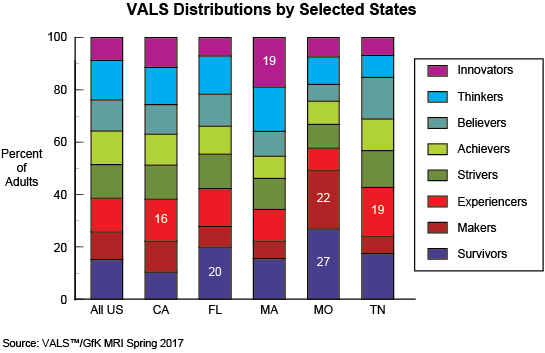VALS by State April 2018
US regional characterizations—such as Charming Southerners, West Coast Progressives, New England Independents, and Friendly Midwesterners—have given way to state labels: red or blue—a stark reminder of today's contentious political environment and the dominance of politics in the media. For typical consumer behaviors by state, some characterizations still hold true. For example, consumers in Alabama and Georgia are unlikely to buy snow tires (although, perhaps as a result of climate change, they should do so), and consumers in Maine are unlikely to buy surfboards. However, recent sport-utility-vehicle and truck sales suggest that more consumers than previously—even urbanites—are enjoying off-road activities or hauling oversize loads.
People living in particular states may exhibit some differences in consumer behaviors from behaviors of people living in other states, but it's differences in the distribution of VALS types that give a state a unique flavor. A person's VALS type doesn't alter on the basis of where the person lives. And regardless of VALS type, consumers in Alabama remain unlikely to buy snow tires.
In spring 2017, our national data partner, GfK Mediamark Research (MRI), added state residency to its database. Some states have smaller populations than others. As a result, even in a robust sample of roughly 24,000 adults age 18 and older, MRI groups states with small populations to achieve sufficient sample size; for example, it groups Wyoming, Montana, and Colorado. We are able to learn the VALS types of the state residents from weightings to the national-population distributions. The following figure illustrates a sample of selected states with VALS distributions that vary significantly from the national norm.

Looking for the states where you're most likely to find the VALS type that matches your target?
- In comparison with the national distribution of Innovators (9%), five individual states and five state groupings have above-average proportions of Innovators; Massachusetts has the highest proportion (19%); Alabama/Mississippi has the fewest Innovators residents (2%).
- The national distribution of Thinkers is 15%. Three state groupings have above average proportions of Thinkers: Maine/New Hampshire/Vermont has the highest proportion (25%). The state of Tennessee has the lowest proportion of Thinkers (8%).
- Three individual states have above-average proportions of Believers (12%): Kentucky (16%) and Tennessee (16%) have the greatest proportion. The state grouping of North Dakota/South Dakota has only 4% of Believers residents.
- Above-average proportions of Achievers (13%) are in three individual states and four state groupings. New Jersey has the highest proportion of Achievers (18%). Indiana has the lowest proportion of Achievers (8%).
- Strivers (13%) in above-average proportions are in two state groupings and three individual states. North Dakota/South Dakota is the highest state grouping, with 21% Strivers; the Minnesota/Iowa state grouping has the lowest proportion (6%).
- Five individual states and three state groupings are the most likely places to find above-average proportions of Experiencers (13%). The state with the highest proportion of Experiencers is Tennessee (19%); the state groping of North Dakota/South Dakota has the fewest (4%).
- Makers represent 11% of all US adults. Five individual states and two sate groupings have above-average proportions of Makers; Indiana (16%) has the highest proportion; the state grouping of North Dakota/South Dakota has the fewest Makers (4%).
- Survivors are good targets for a limited number of products and services. Five individual states and three state groupings have the above-average proportion of 15%. Missouri (27%) has the highest proportion of Survivors; the state grouping of Montana/Wyoming/ Colorado has the fewest Survivors (4%).
Illinois is the only state in the continental United States that reflects the national distribution of VALS types.
To learn more about the VALS types and the most appropriate VALS target for your business, contact us.
Visit the Why-ology Library and VALS homepage for more articles. Now featured: